The efficiency of solar cells is reduced when electron-hole pairs recombine before they can be effectively utilized. When the semiconductor absorbs light at the appropriate wavelength, electron-hole pairs are generated. Under illumination, the carrier concentration in the material exceeds its equilibrium value. Once the light source is removed, the carrier concentration decays back to its equilibrium state in a process commonly referred to as recombination. Below are several different recombination mechanisms:
1. Radiative Recombination
Radiative recombination is the reverse of the light absorption process, where an electron transitions from a high-energy state back to a lower energy state, releasing the excess energy as light. This type of recombination is significant in semiconductor lasers and light-emitting diodes (LEDs) but is not dominant in silicon solar cells.
2. Auger Recombination
Auger recombination is the reverse process of impact ionization. When an electron and hole recombine, the excess energy is transferred to another electron instead of being released as light. The excited electron then relaxes back to its original state, releasing phonons (vibrational energy). Auger recombination becomes particularly pronounced in heavily doped materials, especially when the impurity concentration exceeds 10¹⁷ cm⁻³, making it the dominant recombination process in such cases.
3. Trap-Assisted Recombination
Impurities and defects in semiconductors create allowed energy levels within the forbidden bandgap. These defect energy levels facilitate a two-step recombination process: an electron first relaxes from the conduction band to the defect level and then to the valence band, where it recombines with a hole. This process is highly effective in promoting recombination and can significantly affect the performance of solar cells.
4. Surface Recombination
The surface of a semiconductor can be seen as an area with a high concentration of defects due to the crystal structure’s termination. These surface defects create numerous energy states within the forbidden bandgap, where recombination can occur easily. Surface recombination is a significant factor because the crystal structure at the surface is highly irregular, making recombination more likely to occur in these regions.

Conclusion
In practical solar cells, these recombination mechanisms contribute to overall performance losses. The task for cell designers is to minimize these losses to improve efficiency. Each recombination process presents different challenges, and overcoming these through material selection, surface passivation, and optimized doping levels is essential for enhancing the performance of solar cells. Additionally, distinct design features differentiate various commercial solar cells in the market, influencing their efficiency and application potential.







